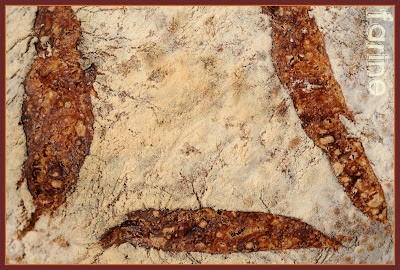Tartine's Basic Country Bread (baked two ways)
vote now

 Baking started in a hot oven
Baking started in a hot ovenWe'll be moving to the Pacific Northwest next year, probably sometime in the spring. Considering how costly such a move is bound to be, we have started divesting ourselves of whatever we can bear to part with. Almost first to go, I am sorry to say, have been stacks and stacks of books, some of which had traveled with us from Europe thirty years ago. But it would probably cost more to ship them that to buy them again (although some of them are no longer in print and cannot be replaced)...
Our local library was accepting book donations last Sunday and you should have seen the elderly volunteer's eyes light up when we pulled over with our carload. He hurried away to get a cart and couldn't stack the boxes on it fast enough. I guess he didn't want to give us a chance to change our minds. I felt a twinge of sadness abandoning these old companions but the Man said: "It's okay. There'll be new books..." and I felt some degree of comfort in that thought. Plus I like the idea of our books being adopted by book lovers.
I know there are new books in our future and I do look forward to discovering them. Most of them will probably be stored on our Kindles however as we won't have as much shelf space in our new home and many will actually be old since the Web offers a huge selection of books that have passed out of copyright, books I might never have access to otherwise and that I enjoy tremendously.


But have you tried reading a cookbook on a Kindle, or rather cooking from one? I have and I found it challenging to say the least. So just as I drew the line at giving away any of my cookbooks (I did last time we moved and ended buying some of them again), I still find myself buying bread-books when they catch my attention with their siren-song, which is what happened with Chad Robertson's Tartine Bread. Once I had it in my hands, Chad's conversational tone and the pull of Eric Wolfinger's photographs were too much for me and I bought it even though it will now have to be schlepped cross-country! I just couldn't resist the urge to read it (our library doesn't carry it yet).
Chad advises the home baker to bake Tartine's basic country bread in a dutch oven combo such as this onein order to gain "the two main characteristics of a professional brick oven: a sealed moist chamber and strong radiant heat".
Now I have been baking round loaves in my dutch oven for years and truly love the way the bread comes out. But I was intrigued by the fact that Chad recommends pre-heating both the oven and the dutch oven so that the dough can be turned out into a hot pot. I have had excellent results with cold bakes (setting the dough in a cold dutch oven and putting said dutch oven in a cold oven). I find it much less dangerous to my health to handle a cold cast iron pot than to grapple with a hot one (I confess I am pretty clumsy and I have the scars to prove it).
So I decided to experiment. I made a batch of Chad's basic country dough and I baked one loaf cold and the other one hot. The results are a little bit skewed by the fact that I forgot to put the second loaf in the fridge while the first one was cooking, so that it ended up proofing about one hour longer. The kitchen was cool (65 ° F) however, so it may not have made much of a difference but still, the experiment would have been more meaningful if I could have baked both loaves at the same time in two different ovens, one pre-heated with a dutch oven inside and one stone-cold. Alas, I have but one oven...
As it is, I did get different results: cold-baking gave a higher loaf (3.25 inches vs. 3 inches with hot-baking) and a slightly more open crumb. Of course when you mix enough dough for two loaves, unless you have access to two ovens and two dutch ovens, you will always be in a situation where you'll have to do at least one hot bake. ;-) But why not bake the first one cold? In my experience the dough loves this very slow rise in temperature in a highly humid environment (because of the water present in the dough, there is a lot of steam inside the dutch oven).
Ingredients (for 2 loaves)
700 g + 50 g water @ 80°F/27°C
200 g mature levain (100% hydration) (fed with 50% all-purpose unbleached flour and 50% La Milanaise's sifted flourwhich is high-extraction and contains some bran. Regular whole-wheat can be substituted maybe with a pinch of dark rye for flavor)
900 g all-purpose unbleached flour
100 g whole-wheat flour (I used freshly milled)
22 g salt (Chad uses 20 g but I adjusted for the flour in the levain)
Method
Note that you can choose to make this dough over two days as a matter of convenience or to get a different flavor if you set the loaves to rise in the fridge overnight or for up to 12 hours. The dough is hand-mixed in a large bowlbut mixing time is kept to a minimum. I won't go into great details as the process is pretty straight-forward but here is what I did.
As recommended by Chad, I started by mixing the levain with 700 g of water (reserving the extra 50 g), then I added the flours and mixed until all the flour was thoroughly hydratedI let the mixture rest for 40 minutes (autolyse)Then I added the salt and the reserved water and I did as many folds as necessary (still in the bowl) until the dough was cohesive and reasonably smoothI transfered it to a lidded plastic container and set it to ferment at 80°F/27°C, using the proofing box the Man put together for me a couple of years ago on the model of this oneI gave it three folds (inside the container) at roughly one-hour intervals and stopped the fermentation after 4 hoursI divided the dough in half, pre-shaped each half in a round, let them relax 10 minutes and shaped them as boules which I set to proof in basketsProofing (in a large clear plastic bag) lasted 2 hours and fifty minutes (at room temp but under the kitchen lamp which does provide some heat)I dusted the top of one loaf with semolina flour and covered it with a sheet of parchment paper. I quickly inverted the basket over the paper and using the sheet of paper as a sling, transferred the boule to my cold dutch ovenI dusted the loaf with flour and scored it in an x pattern, set the lid on the dutch oven and put the whole thing in the cold ovenI set the oven temperature to 470°F/243°C and pressed the start buttonI let the loaf bake covered for 45 minutes, then I took it out of the dutch oven (using heavy oven mitts) and, removing the parchment paper, set it directly on the heated baking stone (this stone is a permanent fixture in my oven) and let it bake another 20 minutes at 455°F/235°C, then I took it out of the oven and set it to cool on a rack where it promptly started making wonderful crackling musicFollowing Chad's instructions, I then pre-heated the oven to 500°F/260°C after putting the by-now barely warm dutch oven inside with the lid onI then transferred the second loaf to a piece of parchment paper after dusting the top (which quickly became the bottom) with semolina flour and with some trepidation (and heavy oven mitts) removed the now boiling-hot dutch oven from the oven. Again using the paper as a sling I set the loaf inside the pot, dusted it with flour, scored it in a square pattern, closed the lid and set the whole contraption back in the ovenI immediately reduced the oven temperature to 450°F/232°C and let the loaf bake, covered, for 20 minutes. I then removed the lid and let it finish baking in the open dutch oven for 25 minutes. I set it to cool next to the other loaf and it too started to make music pretty soon.
Note that immeditately after, both loaves were registering an internal temperature of 215°F/102°C which indicated that they were fully baked.
Baking started in a cold oven
Baking started in a hot oven
We haven't sliced open the second loaf (which is intended for our daughter's family) but I doubt there will be much of a difference between the two, taste-wise. I do like the taste and texture of Tartine's basic country bread but bread is like love (and as the old French saying goes, love is like Spanish inns: in the old days at least you only found in them what you brought to them. My apologies to Farine's Spanish readers. I have no clue as to whether or not French inns were truly any better than Spanish ones in those days and I certainly don't mean to be insulting. What I do mean to say is that the better the ingredients, the better the bread.
I love the taste of the levain when it isn't entirely white and failing access to La Milanaise's sifted flour you may want to use a bit of rye to give your starter a more interesting flavor. Likewise, for whole wheat flour, I use red hard winter wheat I bought last summer in Vermont from Jack Lazor at Butterworks Farmsand I mill it just before mixing. I love its fragrance and its taste. Not everybody has the time or the desire to mill grain before baking but what is true of the grain is true of the flours: some are more flavorful than others. It is a good idea to shop around and try different ones to determine which one brings out the best flavors in your bread. I know for a fact that my bread became much better when I started looking for tastier alternatives to supermarket flours (I still use big brand flours for all-purpose though). So hats off to Chad and his basic country loaf: it does showcase the flavor of the grain and it is pretty easy to make (provided one exercises caution when handling the hot dutch oven). But do start the first loaf in a cold oven. It saves energy and it yields excellent results.
Tartine's basic country bread goes to Susan from Wild Yeastfor this week's Yeastspotting.
Farine
Comments